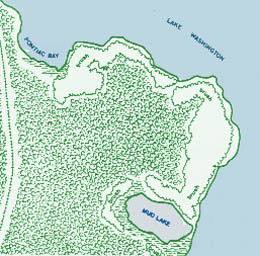On September 5, 1868, William Goldmyer (1843-1924) is the first homesteader to settle on a point jutting into Lake Washington, later called Sand Point. (Sand Point in on the western, Seattle side of the lake). In his mid-20s, Goldmyer arrives in King County after hiking from California. He homesteads 81 acres immediately south of what was later named Pontiac Bay. He establishes a farm, marries Rebecca Spray, and starts a family before selling the property in January 1878 and moving to Fall City in eastern King County.
The Hike From California
William Goldmyer (aka Goldmeyer or Goldmier) was born in 1843 at Triadelphia, Virginia. By the end of the 1840s, his German-born parents had moved to Cincinnati. At or near his 18th birthday, William Goldmyer headed for California. He arrived at San Francisco in mid-November 1861. After more than a year in California, Goldmyer decided to go north. On July 3, 1863, perhaps after walking the entire distance through California and Oregon, he crossed the Columbia River into Washington Territory at the Cascades. According to Goldmyer, he continued his “tramp” on foot in order “to get a good view of the country.” He hiked along the north side of the Columbia River and then over the Cowlitz route through Monticello to Olympia via Cathlament and Grand Mound in three days. He stayed in Olympia for two weeks and then continued his trek along the east side of Puget Sound until he reached King County.
When William Goldmyer arrived at Sand Point, he apparently had a dispute with Lyman B. Andrews over which portions of Sand Point land each would be able to acquire from the Federal Government. (Disputes between individuals over conflicting homestead claims were not unusual.) In 1868, after the dispute was resolved, William Goldmyer homesteaded on 81.45 acres of land located immediately south of a bay later called Pontiac. His land had a two-foot wide stream flowing through it.
Cutting Down the Trees
The 1870 U.S. Census lists William Goldmyer (age 26) as a logger next to Norwegian K. Olson (age 41), who was also listed as a logger. It is likely that they helped each other log their respective properties because the following year a census conducted by Washington Territory lists William Goldmyer (age 27) and Knud Olson (age 41) as farmers living in different houses in the general vicinity of Lake Washington.
Undoubtedly, at this time much of the forest near the west Lake Washington shoreline north of Union Bay was logged. The 1870 census near Lake Washington lists, in addition to "Goldmyer & Olson," groups of logging crews composed of three, nine, and 12 men. Since loggers cut down trees using axes, and since oxen provided the horsepower to drag the logs to water, most logging was done in forested areas near lakes, streams, or Puget Sound.
By 1871, William Goldmyer’s 21-year-old brother Henry was living with him. Census records listed both men as farmers. It is likely they also spent time logging along Lake Washington and Lake Sammamish.
William's Romance
It was perhaps while logging near Lake Sammamish that William Goldmyer got to know Rebecca J. Spray, who lived with her parents in the Sammamish Valley. When he proposed to marry her, she accepted. The young couple married at her parents’ house on Christmas Day 1874 (a date that may have made their wedding anniversaries easy to remember). Probate Judge Waldo M. York conducted the ceremony before witnesses Henry H. Goldmyer and Ira Woodin, founder of Woodinville.
The Goldmyers started a family while living at their Sand Point farm. Daughter Mary C. was born around 1876. Another daughter, listed in census records only as “E. J.,” was born around 1877. After their move to Fall City, the couple had at least five more children.
A Brother's Death
On June 2, 1877, Dr. York conducted another service for the Goldmyers at the opposite end of the spectrum. This was the funeral following the tragic death of William’s brother Henry H. Goldmyer. The service was held at Yesler Hall in Seattle. On May 30, 1877, Henry was part of a crew bringing a raft of logs down Squak Slough (also called Sammamish Slough) when he slipped, hit his head, and drowned. The following day Indians located his body, which was transported to Seattle for the funeral and burial.
In 1878, the Goldmyers moved to Fall City and established a farm. In the late 1890s, William Goldmyer started prospecting and from 1897 to 1903 staked at least 13 mining claims in eastern King County with names such as Blue Grouse, Homestake, Hot Stuff, Good Luck Extension #1, and Clara Mines.
In 1901 or early 1902, after a 17-year marriage, Rebecca Spray Goldmyer died. A few years later William moved to Thurston County to live near one of his daughters. There is a William Goldmyer born in 1843 who died on April 4, 1924, who is buried in Oakville, Grays Harbor County, who is very likely him.

